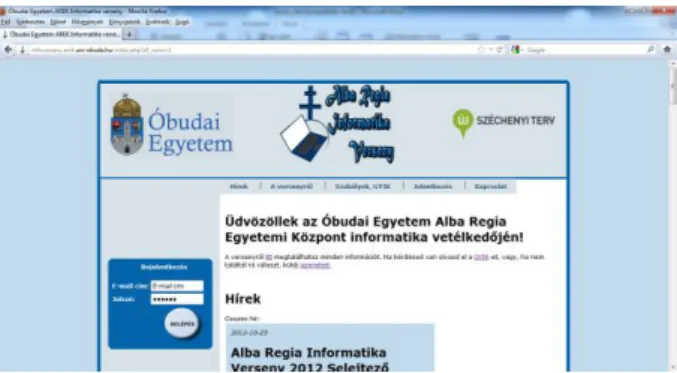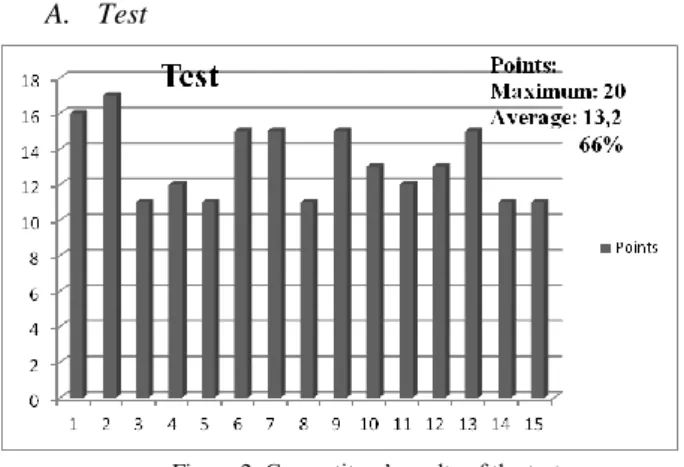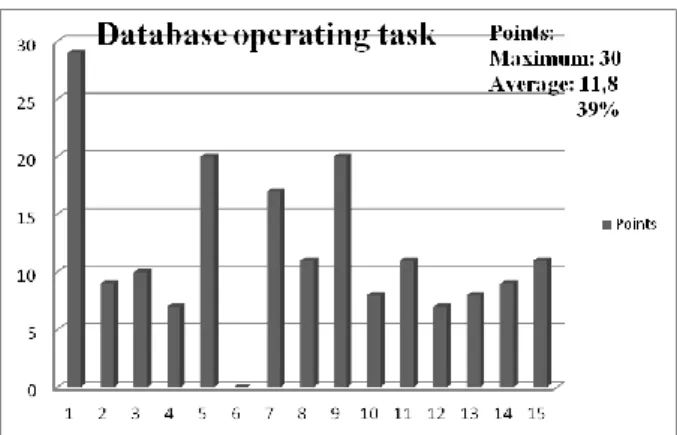Alba Regia Competition of Applied Informatics as a Special E-Learning Field
Dávid András, Maróti Bence, Burián Ágnes, Hajnal Éva Óbuda University, Alba Regia University Center H-8000 Hungary Székesfehérvár, Budai str. 45, Hungary,
david.andras@arek.uni-obuda.hu maroti.bence@indamail.hu burian.agnes@arek.uni-obuda.hu
hajnal.eva@arek.uni-obuda.hu
Abstract— The Alba Regia Competition of Applied Informatics has been organized for secondary grammar school students in the third year since 2010. The competition is executed in e-learning system. For this purpose we designed special software and system of rules. The competition has two rounds and in the first round all competitors work on own computer at home. The best 15 students are invited into the final round, which is in the university building. In this final the students are working in controlled circumstances, with the same software. This paper focused on the special organizational questions, on the main type of tasks and statistical aspects of this work.
I. INTRODUCTION
Psychological studies [1] and everyday experience proves that teenagers are eager to compete with each other. Secondary school students like to compare their abilities and knowledge to other students’, being inspired to improve further their knowledge by their achievement.
So Alba Regia University Center, as the main place of Informatics studies in Fejér county, considered it a demand to organize an informatics competition.
Considering the cost and organizational tasks of such a competition, we decided to organize it in e-learning system [2]. This is not without a precedent [3], there is a good example in the field of programming. In traditional competitions the first round is organized in secondary schools, which needs a strong support from these schools and also sufficient computer facilities. Moreover, a traditional type competition requires inspectors and teachers, which means extra costs. In contrast to this, e- learning system requires only one large investment at the beginning: buying or developing a special software.
Afterwards the comletition can be organized easily and at a low cost. We would like to sum up the organizational questions of the competition on the basis of two years’
experience.
II. DESCRIPTION OF THE COMPETITION
The main goal of the competition is to create interest in informatics and to give further motivation to interested and talented students.
Our aim is to enable students to evaluate their knowledge and prepare for their final exams and university or college studies.
Our second aim is to make our University well-known among the secondary school students of Szekesfehervar and its neighbourhood.
A. The main topic of the Alba Regia Informatics Competition
The topic of the competition is primarily the use of informatics applications according to the advanced maturity exam. Since 2011 algorithmic task was also included.
B. The e-learning software of the Alba Regia Informatics Competition
Figure 1. A screenshot of the e-learning software
We developed a special e-learning software for the purposes of the competition. Its database contains all particulars of all registered users, the tasks, the points of competitors. The program enables the competitors and administrators to log in. It lets the competitors download the task sheet during the time of the competition. It also corrects and grades the test automatically and makes possible for the competitors to upload the task files. It sends a warning before the closing time of the competition, but does not closethe file uploading at the given time. It subtracts 10% of points after every extra minute instead.
The administrators have the authority to edit the website and task sheets, and to correct and mark the task sheets.
Afterwards the program automatically generates statistical data of the competition.
C. The announcement of Alba Regia Informatics Competition
The competition was announced primarily in secondary schools of Fejér county, but we also accepted the registration of students from other places, even from abroad. We had 78 registered competitors last year, 15 of them got in the second round.
We accepted the registration of competitors from all grades of all types of secondary schools, including 4, 6 and 8 grade secondary schools.
D. The structure of the Competition The competition consists of two rounds.
The first one is a qualifying round, which means that students do their assignment at home or at school. The task sheet consists of theoretical tasks and applied informatics tasks at the level of the A-level final exam. It also includes a simple algorithm generating task. Students are provided with a sample task sheet which they can see on the website after registration.
Competitors who proved to be the best in the qualifying round can take part in the second round. This is located in our University Center.
The task sheet of the second round is similar to the first one, the e-learning software is also the same, but students cannot use any kind of help, especially not an external internet connection.
Students have to complete a complex task sheet in both rounds. They have to upload the completed task sheet on the website according to the rules described there.
E. The tasks
The task sheet contains the following tasks:
Test
Static website creation task
Spreadsheettask
Database management task
Algorithm task
We are going to describe briefly the task sheet of the 2011 competition.
1. Test
The theoretical test consists of 20 simple choice questions. It requires knowledge of the history of informatics (including Hungarian references), and the ability to solve problems that must be familiar to all those who use the computer regularly.
Although time is limited and there is no help available in the second round, test results show that students are quite knowledgeable in informatics. Statistical figure 8.
shows they achieved the result of 66% in the test.
2. Static website creation task
Competitors had to place a text, some pictures, a chart and a functioning link on the static website. Students had to carry out the task following the instructions and they were given a picture file. The task itself is not very complicated, but makes possible the measure the students’ knowledge of HTML language and its use.
However in the secondary grammar school the HTML protocol is not required, this task may be solved only by the understanding the basis of it.
3. Spreadsheet task
Competitors had to use EXCEL to create a device that helps to fill in the fashionable Sudoku puzzle. Although it contains a lot of operation from the basic formatting to the formulas, functions, and charts, the competitors
possibly have fun to solve this imaginative task.
Naturally for the work they got more precise instructions.
4. Database management task
Competitors were given the data in 3 text file. After data import and creation of the relationship between tables the competitors must have make different queries and sorts. Finally the result of a query must be exported into an Excel sheet and be created a chart. Task 2. and 3.
requires knowledge that is essential in almost every area of work nowadays.
5. Algorithm task
This task contains an interpretation exercise of a simple conversion algorithm. Simply questions help the solution, which lead the competitors from the simplest case to the mathematical abstraction. This task is different from the other, because it is not a task for the usage of an application, but it measures the ability of the algorithmic thinking.
F. Taking part in the competition A. Registration
Students could register for the Alba Regia Informatics Competition at http://infoverseny.arek.uni-obuda.hu.
Participants could find all information and rules on the website. The FAQ menu point provided answers for frequently asked questions. A special feature of the website is that it contains a sample task sheet that enables students to weigh the level of difficulty of the tasks.
59 students registered on the website in 2010, 21 of them took part in the first round and 15 of them qualified for the second round. In 2011 78 students registered, 38 took part in the first round and 15 of them qualified for the second round.
III. RESULTS, STATISTICS
In the following we will briefly sum up the result statistics of the individual tasks.
A. Test
Figure 2. Competitors’ results of the test
All competitors completed the test well. On one hand, it indicates the competitors’ theoretical knowledge. On the other hand, it shows there is no point in having a test in the second round in the future. Naturally, the test can still be a useful tool in the first round of the competition.
B. Static website creation task
The average result was 79%. From the maximum of 25 points competitors reached 19.87 points on average. As
you can see in figure 3., most students completed the task well (except 4 students).
This result is not unexpected, as we designed this task to be the easiest one.
Figure 3. Competitors’ results of website designing task C. Spreadsheet operating task
The average result was 46%. From the maximum of 25 points students reached 11.4 points on average.
This task was a more complex one, so it proved to be more difficult for the competitors to complete. This is no surprise, as we designed this task to be the most difficult one. This task was one of the diverging problem.
Figure 4. Competitors’ results of spreadsheet operating task D. Database management task
The average result was 39%. From the maximum of 30 points competitors reached 11.8 points on average. As you can see in figure 5., 1 competitor produced an outstanding achievement, while most competitors produced results under 50%. Although this task was not very difficult, students did not have extensive knowledge of the topic, as it is taught only in the 12th (last) grade of secondary schools.
Figure 5. Competitors’ results of database operating task E. Algorithm task
The average result was 20%. From the maximum of 10 points students reached only 2.03 points on average. As you can see in figure 6., with the exception of 2 students competitors had results of under 50%. Poor results are partly due to lack of time. The other reason must be the fact that there are few chances to improve algorithmic thinking in secondary schools.
Figure 6. Competitors’ results of algorithm task F. Summary
Figure 7., illustrates the results of the individual competitors. As it is clear from the diagram, the winners of the competition are students number 1, 7 and 9.
Figure 7. Results of the individual competitors Let’s examine the results of these three students! As you can see in figure 8., the three students had very similar results in the test, the website designing and the spreadsheet operating task.
It was the database operating and the algorithm generating tasks that gave the winner the chance to prove his outstanding abilities and knowledge.
Figure 8. Results of the three best competitors
Figure 9. Results achieved in the five tasks
Figure 9. shows that students reached results of under 50% in the spreadsheet operating, database operating and algorithm generating tasks. We have found a lot of unfinished tasks on the task sheets while correcting them.
The reason of this can be the difficulty of those tasks and also the very limited time competitors had to complete the task sheet.
IV. DISCUSSION
For the support of talented students and for the help of the preparing the advanced final exam, and finally for the reputation of our university a competition of applied informatics was organised in e-learning way. For this purpose a special e-learning software was developed, and the methodology of this competition was elaborated. The
on-line software can indicate the awareness with the number of visitors. Nowadays some internet search engines take our website into the second place in the informatics competition keyword. Till now the competition was organized 2 fold, during that period the number of participants and schools continuously increased. After the two occasions it is worth examining how can it serve our aims, and how can it do its mission.
The statistical analysis of the results show, that the worksheet is capable to measure the knowledge and skills of the students, because the distribution of the points is uniform, and the difference between the best and worst points is quite large. The test pointed the weakness of students, generally the database management and algorithm task. Further success is the pleasant and inspirational atmosphere of the competition and enhanced the image of our university. Few participants took part in the competition again. The winners got valuable gifts due to the financial support. Later some participants choose our university courses after the secondary grammar school. Besides the successes there are some field need further development. Firms and foundations are required to involve the financial support of the competition. The other task is to raise the interest of the media.
ACKNOWLEDGMENT
We thank TÁMOP 4.2.2/B for financial support of our work.
REFERENCES
[1] Mönks and Knoers, Fejlődéslélektan - mesterek mesterei - Urbis Könyvkiadó, 2004
[2] Aldrich, Simulations and the Future of Learning An Innovative (and Perhaps Revolutionary) Approach to e- Learning, Pfeiffer San Francisco. 2004
[3] web:http://www.hsin.hr/coci/ 29.10.2012.



